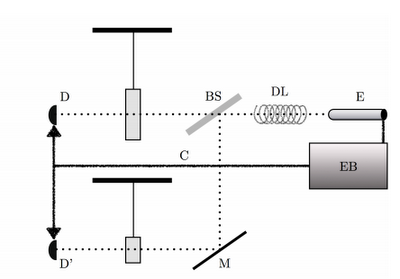

| Visitors Now: | |
| Total Visits: | |
| Total Stories: |

| Story Views | |
| Now: | |
| Last Hour: | |
| Last 24 Hours: | |
| Total: | |
Using conservation of momentum to detect the Planck scale quantum foam
From
Arxiv – Is a tabletop search for Planck scale signals feasible? (8 pages)
Quantum gravity theory is untested experimentally. Could it be tested with tabletop experiments? While the common feeling is pessimistic, a detailed inquiry shows it possible to sidestep the onerous requirement of localization of a probe on Planck length scale. I suggest a tabletop experiment which, given state of the art ultrahigh vacuum and cryogenic technology, could already be sensitive enough to detect Planck scale signals. The experiment combines a single photon's degree of freedom with one of a macroscopic probe to test Wheeler's conception of spacetime foam”, the assertion that on length scales of the order Planck's, spacetime is no longer a smooth manifold. The scheme makes few assumptions beyond energy and momentum conservations, and is not based on a speci c quantum gravity scheme
A particle accelerator would require 10**19 GeV to detect the Planck scale.
We propose the idea for a table-top experiment which, depending on the outcome, may confi rm the radical texture of sub-Planckian spacetime, and decide whether the Planck scale is very small or merely microscopic. The idea, in brief, is to use a single optical photon which traverses a dielectric block to engender a translation of the block which can be arranged to be of order the Planck scale. The translation does not hinge on giving a permanent impulse to the block. Certifi cation that the tiny translation actually occurred is to be had from detecting the photon after transit through the block and relying on momentum conservation. But, as discussed below, translation by a distance of order `P is expected to be disfavored. Thus if in a series of like experimental runs the frequency with which the photon is found to get through the block falls short of expectations (from the block's classical transmission coeffi cient), this may signal that spacetime is \rough” at the relevant scale. The scale at which spacetime ceases to be smooth could thus be experimentally determined.
Set up of suspended blocks showing (dotted) the alternative paths for the photon. E is the single-photon emitter, D and D' are the single-photon detectors. BS denotes the beamsplitter and M the mirror. DL is the fiber optics delay line, and EB are the electronics that trigger D and D' through cable C. The optical elements to widen the beam before and focus it after each block are left out for clarity. In the real experiment the blocks would hang side by side.
Technology Review has coverage
See more and subscribe to NextBigFuture at 2012-11-24 22:01:53 Source: http://nextbigfuture.com/2012/11/using-conservation-of-momentum-to.html
Source:



